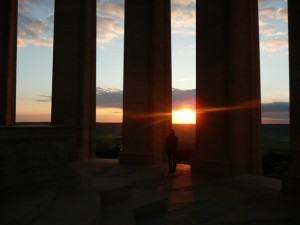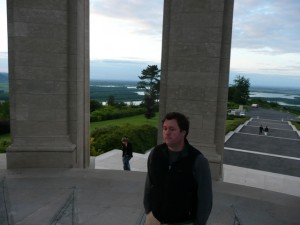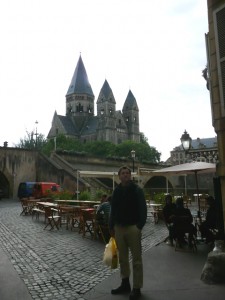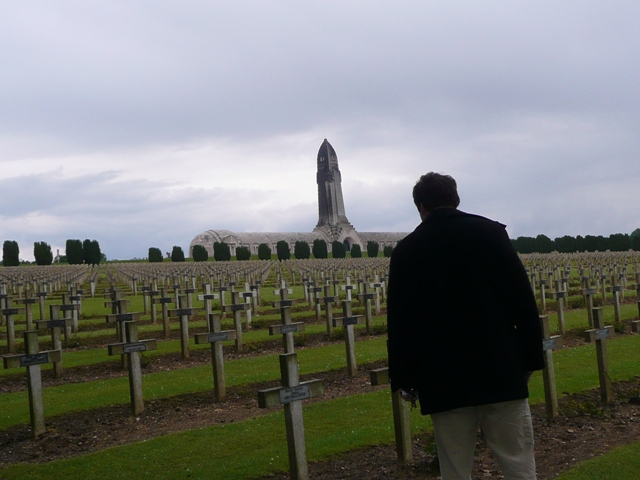 Now I confess to being a bit of history buff. Real history often makes better reading than any fiction. So I wanted to visit at least one of the World War One battlefields of northern France. I would have preferred the Somme, where my granddad served and was captured, or Arras, but that would have required a significant amount more driving, and Verdun lay between us and the bubbly producing towns of Champagne. After Luxembourg, and staying at the camping ground of god’s waiting room (couples in their 80’s staring motionless at the grass all day), we swung through the pretty cathedral town of Metz, where i had a beer and watched the Germany v Romania game in a cafe with an excitable deaf romanian, we went southwest into the forest near the Moselle River looking for a place to camp. I can’t think of moselle without thinking of barbeques in Australia in the late 70’s and the women getting
Now I confess to being a bit of history buff. Real history often makes better reading than any fiction. So I wanted to visit at least one of the World War One battlefields of northern France. I would have preferred the Somme, where my granddad served and was captured, or Arras, but that would have required a significant amount more driving, and Verdun lay between us and the bubbly producing towns of Champagne. After Luxembourg, and staying at the camping ground of god’s waiting room (couples in their 80’s staring motionless at the grass all day), we swung through the pretty cathedral town of Metz, where i had a beer and watched the Germany v Romania game in a cafe with an excitable deaf romanian, we went southwest into the forest near the Moselle River looking for a place to camp. I can’t think of moselle without thinking of barbeques in Australia in the late 70’s and the women getting stuck into the the green casks and bottles of ‘Moselle’ wine. I picked out the top of the only hill in the area to stay the night, the Butte de Montsec, that turned out to have an American war memorial on top of it like a greek temple. With the red sunset over the lake and escarpments below, and then a big moon rising, it was quite an atmospheric place to park up.
stuck into the the green casks and bottles of ‘Moselle’ wine. I picked out the top of the only hill in the area to stay the night, the Butte de Montsec, that turned out to have an American war memorial on top of it like a greek temple. With the red sunset over the lake and escarpments below, and then a big moon rising, it was quite an atmospheric place to park up.
Karina piloted the VW through the narrow country lanes and villes of the Lorraine countryside, and we had breakfast at Bar-de-luc, which is famous for it’s currants, but we just had a coffee and croque monsiuer (cheesey bechamel sauce and ardennes ham on toast) that was the best I’d ever scoffed.
After that, we choofed north to Verdun. Now Verdun saw some of the heaviest fighting and casualties of the Great war, almost a million dead in 14 months of mainly French and Germans soldiers fighting over the same small patch of blasted earth. You see streets and squares named after it all over France. We went to the citadelle museum in the town and took an amusing electric cart, almost like the Ghost Train at the fair, that had automated film and displays about life inside the citadelle during the battle. It had an effective bit where you were asked to imagine you were flying over the fields of france, with model farms laid out below our cart and a giant fan simulaing the flying experience. As good as it was, it seemed difficult to see how this bit in anyway related to the verdun conflict. It finished by talking about the pride of the french defence and the honour it had won, as our electric car rolled through a Get Smart like tunnel of raising flags, medals and banners with the Marsellie playing. As an afterthought, they mentioned their dedication to peace, which I thought was a bit rich given the previous room. We walked out through a collection of propaganda posters from both French and German sides from the period. My take on it is that the Battles of Verdun, the Somme, and other slaughters like Fromelle and Bullecourt, is that they stand as testiment to how leaders and men can dangerously abuse power, and manipulate societies so they will send men in their millions to be mown down like wheat and blasted to blood and bone, and asked to murder and maim other men, and be at the whim and command of a self aggrandising fools serving their own ambitions, and then call it glorius and honourable, and shout down and humliate and imprison and execute anyone who dissents or refuses to take part. The millions dead should be used as a warning, but even this century we’re still getting dragged into wars that benefit only the few. That’s my two cents. After the citadelle we drove around a few of the nearby battlefields and memorials of the Douamont. The unwooded area still has the overgrown shell craters of 90 years ago and rusting barb wire.
